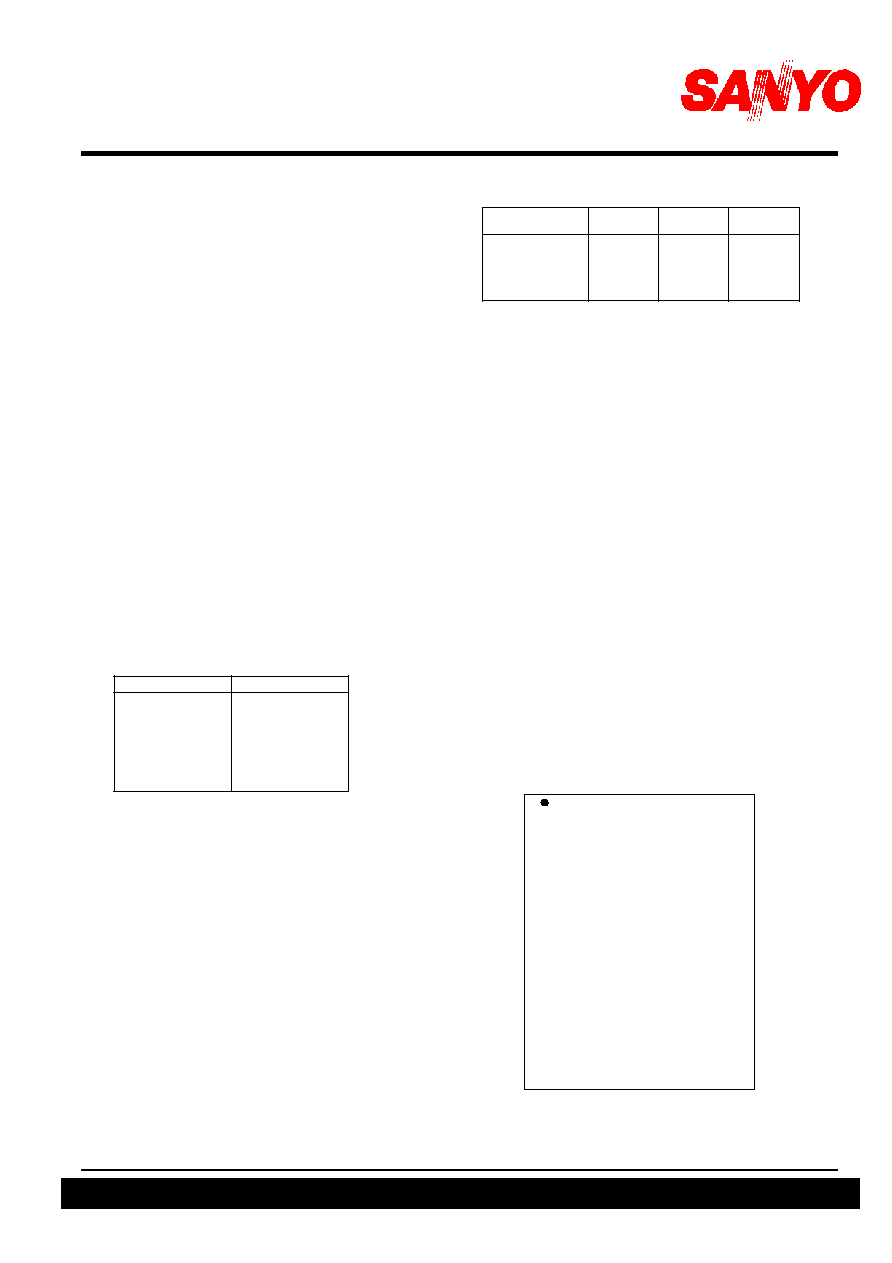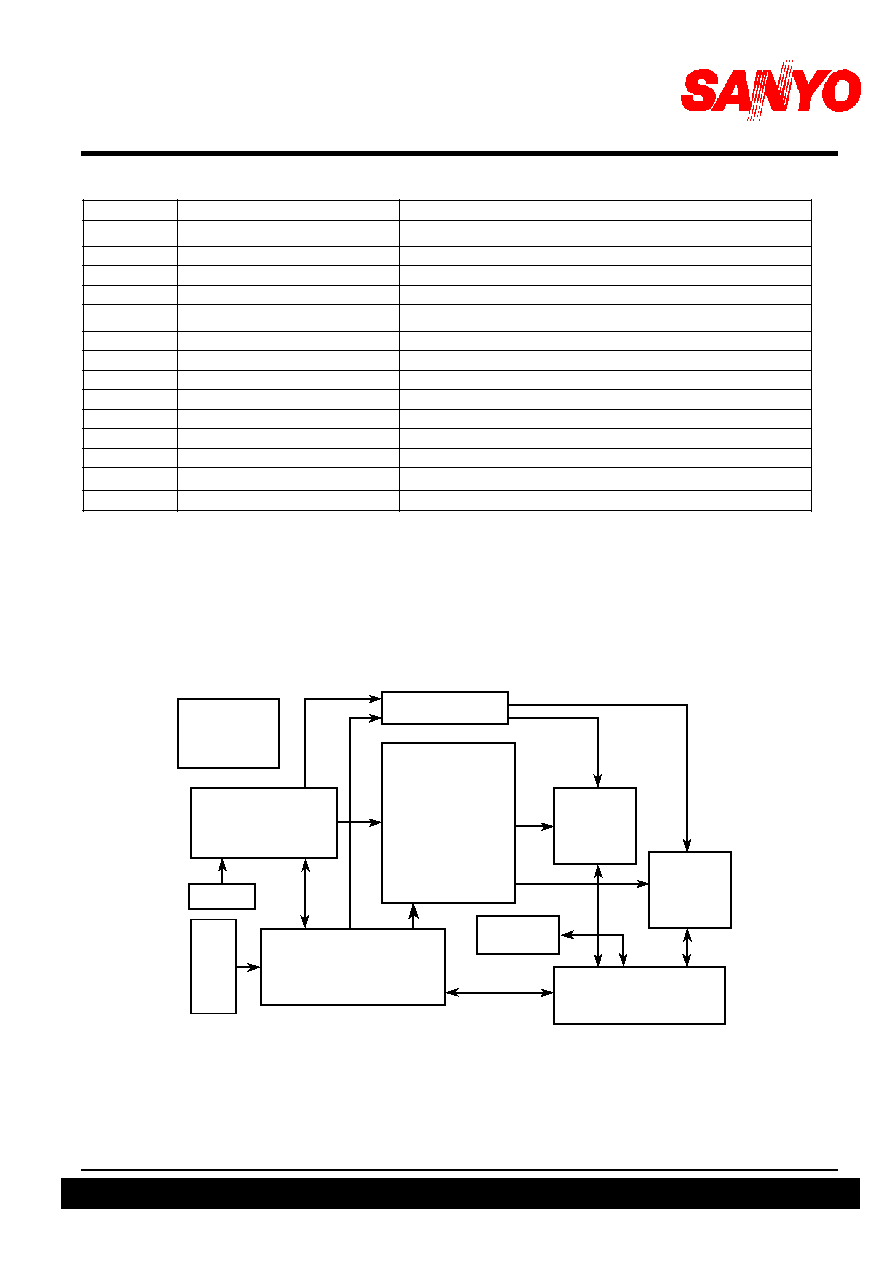
1
16 Megabit FlashBank Memory
LE28DW1621T-80T (Draft3)
1
SANYO Electric Co.,Ltd. Semiconductor Company 1-1-1 Sakata Oizumi Gunma Japan
R.1.20(4/27/2000) No.xxxx-1/20
FEATURES:
∑
Single 3.0-Volt Read and Write Operations
∑
Separate Memory Banks by Address Space
≠ Bank1: 4Mbit (256K x 16 / 512K x 8) Flash
≠ Bank2: 12Mbit (768K x 16 / 1536K x 8) Flash
≠ Simultaneous Read and Write Capability
∑
Superior Reliability
≠ Endurance:
100,000 Cycles (Erase Verify Mode)
10,000 Cycles
≠ Data Retention: 10 years
∑
Low Power Consumption
≠ Active Current, Read:
10 mA (typical)
≠ Active Current, Read & Write: 30 mA (typical)
≠ Standby Current:
5µA (typical)
≠ Auto Low Power Mode Current: 5µA (typical)
∑
Fast Write Operation
≠ Chip Erase + Program:
15 sec (typical)
≠ Block Erase + Program:
500 ms (typical)
≠ Sector Erase + Program:
30 ms (typical)
∑
Fixed Erase, Program, Write Times
≠ Does not change after cycling
∑
Read Access Time
≠ 80 ns
∑
Latched Address and Data
∑
End of Write Detection
≠ Toggle Bit / Data # Polling / RY/BY#
∑
Write Protection by WP# pin
∑
Erase Verify Mode
∑
Flash Bank: Two Small Erase Element Sizes
≠ 1K Words per Sector or 32K Words per Block
≠ Erase either element before Word Program
∑
CMOS I/O Compatibility
∑
Packages Available
≠ 48-Pin TSOP (12mm x 20mm)
∑
Continuous Hardware and Software Data
Protection (SDP)
Product Description
The LE28DW1621T consists of two memory banks, Bank1 is
a 256K x 16 bits or 512K x 8 sector mode flash EEPROM and
Bank2 is a 768K x 16 bits or 1536K x 8 sector mode flash
EEPROM, manufactured with SANYO's proprietary, high per-
formance FlashTechnology. The LE28DW1621T writes with a
3.0-volt-only power supply.
The LE28DW1621T is divided into two separate memory banks.
Bank1 contains 256 sectors of 1K words or 8 blocks of 32K
words, Bank2 contains 768 sectors of 1K words or 24 blocks of
32K words.
Any bank may be used for executing code while writing data to
a different bank. Each memory bank is controlled by separate
Bank selection address (A18,A19) lines.
The LE28DW1621T inherently uses less energy during Erase,
and Program than alternative flash technologies. The total
energy consumed is a function of the applied voltage, current,
and time of application. Since for any given voltage range, the
Flash technology uses less current to program and has a shorter
Erase time, the total energy consumed during any Erase or
Program operation is less than alternative flash technologies.
The Auto Low Power mode automatically reduces the active
read current to approximately the same as standby; thus,
providing an average read current of approximately 1 mA/MHz of
Read cycle time.
The Flash technology provides fixed Erase and Program times,
independent of the number of erase/program cycles that have
occurred. Therefore the system software or hardware does not
have to be modified or derated as is necessary with alternative
flash technologies, whose Erase and Program times increase
with accumulated erase/program cycles.
Device Operation
The LE28DW1621T operates as independent 4Megabit and
12Megabit Word Pogram, Sector Erase flash EEPROMs. Two
memory Banks are spareted by the address space.
The Bank1 is assigned as C0000h to FFFFFh, Bank2 is as-
signed as 00000h to BFFFFh.
All memory banks share common I/O lines, WE#, and OE#.
Memory bank selection is by bank select address(A19, A18).
WE# is used with SDP to control the Erase and Program
operation in each memory bank.
The LE28DW1621T provides the added functionality of being
able to simultaneously read from one memory bank while
erasing, or programming to one other memory bank. Once the
internally controlled Erase or Program cycle in a memory bank
has commenced, a different memory bank can be accessed for
read. Also, once WE# and CE# are high during the SDP load
sequence, a different bank may be accessed to read.
LE28DW1621T which selectes banks (A19, A18) by a address.
It can be used as a normal conventinal flash memory when
operats erase or program operation to only a bank at non-
concurrent operation.
The device ID cannot be accessed while any bank is writing,
erasing, or programming.
Preliminary Specifications
The Flash Bank product family was jointly developed by SANYO and Sillicon Storage Technology,Inc.(SST),under SST's technology license. This preliminary specification is subject to change without notice.

2
16 Megabit FlashBank Memory
LE28DW1621T-80T (Draft3)
2
SANYO Electric Co.,Ltd. Semiconductor Company 1-1-1 Sakata Oizumi Gunma Japan
R.1.20(4/27/2000) No.xxxx-2/20
The Auto Low Power Mode automatically puts the
LE28DW1621T in a near standby mode after data has been
accessed with a valid Read operation. This reduces the I
DD
active read current from typically 10mA to typically 5µA. The Auto
Low Power mode reduces the typical I
DD
active read current to
the range of 1mA/MHz of Read cycle time. If a concurrent
Read while Write is being performed, the I
DD
is reduced to
typically 40mA. The device exits the Auto Low Power mode with
any address transition or control signal transition used to initiate
another Read cycle, with no access time penalty.
Read
The Read operation of the LE28DW1621T Flash banks is
controlled by CE# and OE#, a chip enable and output enable
both have to be low for the system to obtain data from the
outputs. OE# is the output control and is used to gate data from
the output pins. The data bus is in high impedance state when
OE# is high. Refer to the timing waveforms for further details
(Figure 3).
When the read operation is executed without address change
after power switch on, CE# should be changed the level high
to low. If the read operation is executed after programing , CE#
should be changed the level high to low.
Write
All Write operations are initiated by first issuing the Software
Data Protect (SDP) entry sequence for Chip, Block, or Sector
Erase. Word Program in the selected Flash bank. Word
Program and all Erase commands have a fixed duration, that will
not vary over the life of the device, i.e., are independent of the
number of Erase/Program cycles endured.
Either Flash bank may be read to another Flash Bank during the
internally controlled write cycle.
The device is always in the Software Data Protected mode for
all Write operations Write operations are controlled by toggling
WE# or CE#. The falling edge of WE# or CE#, whichever occurs
last, latches the address. The rising edge of WE# or CE#,
whichever occurs first, latches the data and initiates the Erase
or Program cycle.
For the purposes of simplification, the following descriptions will
assume WE# is toggled to initiate an Erase or Program. Tog-
gling the applicable CE# will accomplish the same function.
(Note, there are separate timing diagrams to illustrate both WE#
and CE# controlled Program or Write commands.)
Word Program
The Word Program operation consists of issuing the SDP Word
Program command, initiated by forcing CE# and WE# low, and
OE# high. The words to be programmed must be in the erased
state, prior to programming. The Word Program command
programs the desired addresses word by word. During the
Word Program cycle, the addresses are latched by the falling
edge of WE#. The data is latched by the rising edge of WE#. (
See Figure 4-1 for WE# or 4-2 for CE# controlled Word Program
cycle timing waveforms, Table 3 for the command sequence,
and Figure 15 for a flowchart. )
During the Erase or Program operation, the only valid reads from
that bank are Data# Polling and Toggle Bit. The other bank may
be read.
The specified Chip, Block, or Sector Erase time is the only time
required to erase. There are no preprogramming or other com-
mands or cycles required either internally or externally to erase
the chip, block, or sector.
Erase Operations
The Chip Erase is initiated by a specific six-word load sequence
(See Tables 3). A Bank Erase will typically be less than 70 ms.
An alternative to the Chip Erase in the Flash bank is the Block or
Sector Erase. The Block Erase will erase an entire Block (32K
words) in typically 15 ms. The Sector Erase will erase an entire
sector (1024 words) in typically 15 ms. The Sector Erase
provides a means to alter a single sector using the Sector Erase
and Word Program modes. The Sector Erase is initiated by a
specific six-word load sequence (see Table 3).
During any Sector, Block, or Chip Erase within a bank, any other
bank may be read.
Chip Erase
The LE28DW1621T provides a Chip Erase mode, which allows
the user to clear the Flash bank to the "1"state. This is useful
when the entire Flash must be quickly erased.
The software Flash Chip Erase mode is initiated by issuing the
specific six-word loading sequence, as in the Software Data
Protection operation. After the loading cycle, the device enters
into an internally timed cycle. (See Table 3 for specific codes,
Figure 5-1 for a timing waveform, Figure12 for a flowchart. )
Block Erase
The LE28DW1621T provides a Block Erase mode, which allows
the user to clear any block in the Flash bank to the "1"state.
The software Block Erase mode is initiated by issuing the
specific six-word loading sequence, as in the Software Data
Protect operation. After the loading cycle, the device enters into
an internally timed Erase cycle. (See Table 3 for specific codes,
Figure 5-2 for the timing waveform, and Figure 13 for a flow-
chart.) During the Erase operation, the only valid reads are Data#
Polling and Toggle Bit from the selected bank, other banks may
perform normal read.
Sector Erase
The LE28DW1621T provides a Sector Erase mode, which
allows the user to clear any sector in the Flash bank to the "1"
state.
The software Sector Erase mode is initiated by issuing the

3
16 Megabit FlashBank Memory
LE28DW1621T-80T (Draft3)
3
SANYO Electric Co.,Ltd. Semiconductor Company 1-1-1 Sakata Oizumi Gunma Japan
R.1.20(4/27/2000) No.xxxx-3/20
specific six-word loading sequence, as in the Software Data
Protect operation. After the loading cycle, the device enters into
an internally timed Erase cycle.( See Table 3 for specific codes,
Figure 5-3 for the timing waveform, and Figure 14 for a
flowchart.) During the Erase operation, the only valid reads are
Data# Polling and Toggle Bit from the selected bank, other banks
may perform normal read.
Erase Verify Mode
The LE28DW1621T provides a Erase Verify Mode in order to
improve the erase / programming cycles over ten times greater
than normal mode. The memory cell is given a optimum margin
by executing Chip erase , Block erase or Sector erase after this
mode is excecuted. The Erase Verify flow shoud be executed at
erase operation. If verify operation becomes bad, the re-erase
operation is permited within a reguration times. Refer to Fig.20
for a flowchart at Erase Verify Mode.(See Table3 for specific
codes and Fig.6 for Timing waveform)
When return to a normal mode from Erase Verify mode, the
Erase Verify Exit command should be excuted. This command
is the same as a Software ID Exit mode.(See Table 3 for specific
codes and Fig10 for Timing waveforms.)
Write Operation Status Detection
The LE28DW1621T provides two software means to detect the
completion of a Flash bank Program cycle, in order to optimize
the system Write cycle time. The software detection includes
two status bits : Data# Polling (DQ
7
) and Toggle Bit (DQ
6
). The
end of Write Detection mode is enabled after the rising edge of
WE#, which initiates the internal Erase or Program cycle.
The actual completion of the nonvolatile write is a synchronous
with the system; therefore, either a Data# Polling or Toggle Bit
read may be simultaneous with the completion of the Write
cycle. If this occurs, the system will possibly get an erroneous
result, i.e. valid data may appear to conflict with either DQ
7
or
DQ
6
. In order to prevent spurious device rejection, if an errone-
ous result occurs, the software routine should include a loop to
read the accessed location an additional two (2) times. If both
reads are valid, then the device has completed the Write cycle,
otherwise the rejection is valid.
There is no provision to abort an Erase or Program operation,
once initiated. For the SANYO Flash technology, the associated
Erase and Program times are so fast, relative to system reset
times, there is no value in aborting the operation. Note, reads can
always occur from any bank not performing an Erase or Pro-
gram operation.
Should the system reset, while a Block or Sector Erase or Word
Program is in progress in the bank where the boot code is stored,
the system must wait for the completion of the operation before
reading that bank. Since the maximum time the system would
have to wait is 25 ms (for a Block Erase), the system ability to
read the boot code would not be affected.
Data# Polling (DQ
7
)
When the LE28DW1621T is in the internal Flash bank Program
cycle, any attempt to read DQ
7
of the last word loaded during the
Flash bank Word Load cycle will receive the complement of the
true data. Once the Write cycle is completed, DQ
7
will show true
data. The device is then ready for the next operation. (See Figure
6 for the Flash bank Data Polling timing waveforms and Figure
16 for a flowchart.)
Toggle Bit (DQ
6
)
During the Flash bank internal Write cycle, any consecutive
attempts to read DQ
6
will produce alternating 0's and 1's, i.e.
toggling between 0 and 1. When the Write cycle is completed,
the toggling will stop. The device is then ready for the next
operation. (See Figure 7 for Flash bank Toggle Bit timing
waveforms and Figure 16 for a flowchart.)
Data Protection
The LE28DW1621T provides both hardware and software fea-
tures to protect nonvolatile data from inadvertent writes.
Hardware Data Protection
Noise/Glitch Protection: A WE# pulse of less than 5 ns will not
initiate a Write cycle.
V
DD
Power Up/Down Detection: The Write operation is inhibited
when V
DD
is less than 1.5 volts.
Write Inhibit Mode: Forcing OE# low, CE# high, or WE# high will
inhibit the Write operation. This prevents inadvertent writes
during power-up or power-down.
The LE28DW1621T provides a protect area by hardware pro-
tection. The assigned address is the upper are of 2Mega bit in
Bnak1(E0000 to FFFFFh), which is set up by WP# when low.
When this operation is executed, the functions which are Sector
erase, Block erase or Word program can not be accepted.
When the Chip erase operation is executed, all area will be
erased except protected area.
Hardware Reset Function
The LE28DW1621T provides a Hardware Reset function which
set up by RESET# being low.
RESET# pin need a low puls longer than tRP. It needs a wait
priode while tRESET from Rise edge of RESET#.
The data can't be guranteed to excute the Reset operation while
write operation.
Software Data Protection (SDP)
The LE28DW1621T provides the JEDEC approved software
data protection scheme as a requirement for initiating a Write,
Erase, or Program operation. With this scheme, any Write
operation requires the inclusion of a series of three word-load
operations to precede the Word Program operation. The three-

4
16 Megabit FlashBank Memory
LE28DW1621T-80T (Draft3)
4
SANYO Electric Co.,Ltd. Semiconductor Company 1-1-1 Sakata Oizumi Gunma Japan
R.1.20(4/27/2000) No.xxxx-4/20
Product Identification Table
Device ID codes are unique to each bank. Should a chip ID
be required, any of the bank IDs may be used as the chip ID.
While in the read software ID mode, no other operation is
allowed until after exiting these modes.
Product Identification Mode Exit
In order to return to the standard Read mode, the Product
Identification mode must be exited. Exit is accomplished by
issuing the Software ID exit command, which returns the
device to normal operation. This command may also be
used to reset the device to the Read mode after any inadvert-
ent transient condition that apparently causes the device to
behave abnormally, e.g., not read correctly. For details, (see
Table 3 for software operation and Figures 9 for timing
waveforms.)
word load sequence is used to initiate the Program cycle,
providing optimal protection from inadvertent Write operations,
e.g., during the system power-up or power-down. The six-word
sequence is required to initiate any Chip, Block, or Sector Erase
operation.
The requirements for JEDEC compliant SDP are in byte format.
The LE28DW1621T is organized by word; therefore, the con-
tents of DQ
8
to DQ
15
are "Don't Care"during any SDP (3-word
or 6-word) command sequence.
During the SDP load command sequence, the SDP load cycle
is suspended when WE# is high. This means a read may occur
to any other bank during the SDP load sequence.
The bank reserve in SDP load sequence is reserved by the bus
cycle of command materialization. If the command sequence
is aborted, e.g., an incorrect address is loaded, or incorrect data
is loaded, the device will return to the Read mode within T
RC
of
execution of the load error.
Concurrent Read and Write Operations
The LE28DW1621T provides the unique benefit of being able to
read any bank, while simultaneously erasing, or programming
one other bank. This allows data alteration code to be executed
from one bank, while altering the data in another bank. The next
table lists all valid states.
Concurrent Read/Write State Table
Note: For the purposes of this table, write means to Block, Sector,
or Chip Erase, or Word Program as applicable to the
appropriate bank.
The device will ignore all SDP commands and toggling of WE#
when an Erase or Program operation is in progress. Note,
Product Identification entry commands use SDP; therefore, this
command will also be ignored while an Erase or Program,
operation is in progress.
Product Identification
The product identification mode identifies the device manufac-
turer as SANYO and provides a code to identify each bank. The
manufacturer ID is the same for each bank; however, each bank
has a separate device ID. Each bank is individually accessed
using the applicable Bank Address and a software command.
Users may wish to use the device ID operation to identifythe write
algorithm requirements for each bank. (For details, see Table 3
for software operation and Figures 8 for timing waveforms. )
1
k
n
a
B
2
k
n
a
B
d
a
e
R
n
o
i
t
a
r
e
p
O
o
N
d
a
e
R
e
t
i
r
W
e
t
i
r
W
d
a
e
R
n
o
i
t
a
r
e
p
O
o
N
e
t
i
r
W
e
t
i
r
W
n
o
i
t
a
r
e
p
O
o
N
n
o
i
t
a
r
e
p
O
o
N
d
a
e
R
d
r
o
W
a
t
a
D
)
e
d
o
M
d
r
o
W
(
a
t
a
D
)
e
d
o
M
e
t
y
B
(
D
I
r
e
k
a
M
H
0
0
0
0
H
2
6
0
0
H
2
6
e
d
o
C
e
c
i
v
e
D
1
k
n
a
B
(
)
H
1
0
0
0
H
E
7
5
2
H
E
7
e
d
o
C
e
c
i
v
e
D
)
2
k
n
a
B
(
H
1
0
0
0
H
D
7
5
2
H
D
7
Figure 1 : Pin Description : TSOP-1 (12mm x 20mm)
1
2
3
4
5
6
7
8
9
10
11
12
13
14
15
16
17
18
19
20
21
22
23
24
48
47
46
45
44
43
42
41
40
39
38
37
36
35
34
33
32
31
30
29
28
27
26
25
A15
A14
A13
A12
A11
A10
A9
A8
A19
NC
WE#
RESET#
NC
WP#
RY/BY#
A18
A17
A7
A6
A5
A4
A3
A2
A1
A16
BYTE#
VSS
DQ15/A-1
DQ7
DQ14
DQ6
DQ13
DQ5
DQ12
DQ4
VDD
DQ11
DQ3
DQ10
DQ2
DQ9
DQ1
DQ8
DQ0
OE#
VSS
CE#
A0
(12mm x 20mm)
TSOP-I
Normal Bend

5
16 Megabit FlashBank Memory
LE28DW1621T-80T (Draft3)
5
SANYO Electric Co.,Ltd. Semiconductor Company 1-1-1 Sakata Oizumi Gunma Japan
R.1.20(4/27/2000) No.xxxx-5/20
l
o
b
m
y
S
e
m
a
N
n
i
P
n
o
i
t
c
n
u
F
8
1
A
,
9
1
A
s
s
e
r
d
d
a
t
c
e
l
e
S
k
n
a
B
n
e
h
w
2
k
n
a
B
e
h
t
e
t
a
v
i
t
c
a
o
t
,
h
g
i
h
e
r
a
h
t
o
b
n
e
h
w
1
k
n
a
B
e
h
t
e
t
a
v
i
t
c
a
o
T
.
n
o
i
t
a
n
i
b
m
o
c
r
e
h
t
o
e
h
t
1
-
A
,
0
A
-
9
1
A
s
e
s
s
e
r
d
d
a
k
n
a
B
h
s
a
l
F
s
s
e
r
d
d
a
k
n
a
B
h
s
a
l
F
e
d
i
v
o
r
p
o
T
5
1
A
-
9
1
A
s
e
s
s
e
r
d
d
a
k
c
o
l
B
k
n
a
B
h
s
a
l
F
e
s
a
r
e
r
o
f
k
c
o
l
B
k
n
a
B
h
s
a
l
F
a
t
c
e
l
e
s
o
T
0
1
A
-
9
1
A
s
e
s
s
e
r
d
d
a
r
o
t
c
e
S
k
n
a
B
h
s
a
l
F
e
s
a
r
e
r
o
f
r
o
t
c
e
S
k
n
a
B
h
s
a
l
F
a
t
c
e
l
e
s
o
T
0
Q
D
-
5
1
Q
D
t
u
p
t
u
O
/
t
u
p
n
I
a
t
a
D
e
t
i
r
w
g
n
i
r
u
d
a
t
a
d
t
u
p
n
i
e
v
i
e
c
e
r
d
n
a
e
l
c
y
c
d
a
e
r
g
n
i
r
u
d
a
t
a
d
t
u
p
t
u
o
o
T
.
h
g
i
h
s
i
#
E
C
r
o
h
g
i
h
s
i
#
E
O
n
e
h
w
e
t
a
t
s
i
r
t
n
i
e
r
a
s
t
u
p
t
u
o
e
h
T
.
e
l
c
y
c
#
E
C
e
l
b
a
n
E
p
i
h
C
.
w
o
l
s
i
#
E
C
n
e
h
w
k
n
a
B
h
s
a
l
F
e
h
t
e
t
a
v
i
t
c
a
o
T
#
E
O
e
l
b
a
n
E
t
u
p
t
u
O
.
s
r
e
f
f
u
b
t
u
p
t
u
o
a
t
a
d
e
h
t
e
t
a
g
o
T
#
E
W
e
l
b
a
n
E
e
t
i
r
W
.
s
n
o
i
t
a
r
e
p
o
m
a
r
g
o
r
p
r
o
e
s
a
r
e
,
e
t
i
r
w
e
h
t
l
o
r
t
n
o
c
o
T
#
E
T
Y
B
n
o
i
t
c
e
l
e
s
e
t
y
B
h
g
i
h
n
e
h
w
e
d
o
m
d
r
o
W
a
t
c
e
l
e
s
o
t
,
w
o
l
n
e
h
w
e
d
o
m
e
t
y
B
a
t
c
e
l
e
s
o
T
#
Y
B
/
Y
R
t
u
p
t
u
o
y
s
u
B
/
y
d
a
e
R
Z
-
h
g
i
H
s
i
e
s
a
c
r
e
h
t
o
,
e
t
i
r
w
n
e
h
w
w
o
l
t
u
p
t
u
o
o
T
#
P
W
t
c
e
t
o
r
P
e
t
i
r
W
w
o
l
n
e
h
w
t
c
e
t
o
r
p
e
t
i
r
w
e
r
a
w
d
r
a
H
e
t
u
c
e
x
e
o
T
V
D
D
y
l
p
p
u
S
r
e
w
o
P
)
s
t
l
o
v
6
.
3
o
t
s
t
l
o
v
7
.
2
(
.
y
l
p
p
u
s
s
t
l
o
v
0
.
3
e
d
i
v
o
r
p
o
T
s
s
V
d
n
u
o
r
G
C
N
n
o
i
t
c
e
n
n
o
C
o
N
s
n
i
P
d
e
t
c
e
n
n
o
c
n
U
Table1: Pin Description
Figure2-1: Functinaly Block Diagram
A19-A0,A-1
CE#
OE#
WE#
WP#
DQ15-DQ0
768Kx16
or
1536K x 8
256Kx16
or
512K x 8
RY/BY#
RESET#
BYTE#
X-Decoder
Y-Decoder
Flash Bank2
Flash Bank1
I/O Buffers & Data Latches
Control Logic
Address Buffer
&
Data Latchs
Charge Pump
&
Vref.




